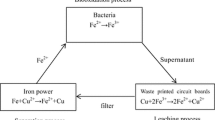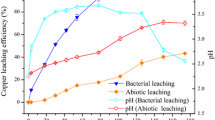Abstract
Acidithiobacillus ferrooxidans, as chemolithotrophic aerobic bacterium, can obtain energy by oxidation of ferrous ions (Fe2+) to ferric ions (Fe3+) and use molecular oxygen (O2) as terminal electron acceptor. In this study, the effects of dissolved oxygen (DO) levels in culture medium on cell growth and copper extraction from waste printed circuit boards (PCBs) were investigated in A. ferrooxidans. The whole culture period was divided into two stages of cell growth and copper extraction. At the former stage, relatively lower DO level was adopted to satisfy bacterial growth while avoiding excessive Fe2+ oxidation. At the later stage, higher DO was used to promote copper extraction. Moreover, shift time of DO from lower to higher level was determined via simulating Gauss function. By controlling DO at 10 % for initial 64 h and switching to 20 % afterwards and with 18 g/l PCBs addition at 64 h, final copper recovery reached 94.1 %, increased by 37.6 and 48.3 % compared to constant DO of 10 and 20 % operations. More importantly, copper leaching periods were shortened from 108 to 60 h. It was suggested that application of DO-shifted strategy to enhancing copper extraction from PCBs with reduced leaching periods is being feasible.





Similar content being viewed by others
References
Li J, Lu H, Guo J, Xu Z, Zhou Y (2007) Recycle technology for recovering resources and products from waste printed circuit boards. Environ Sci Technol 41:1995–2000
Cui JR, Zhang LF (2008) Metallurgical recovery of metals from electronic waste: A review. J Hazard Mater 158:228–256
Lee JC, Song HT, Yoo JM (2007) Present status of the recycling of waste electrical and electronic equipment in Korea. Resour Conserv Recycl 50:380–397
Ludwig C, Hellweg S, Stucki S (2003) Municipal solid waste management: strategies and technologies for sustainable solutions. Springer, Berlin, pp 320–322
Das A, Vidyadhar A, Mehrotra SP (2009) A novel flow sheet for the recovery of metal values from waste printed circuit boards. Resour Conserv Recycl 53:464–469
Niu X, Li Y (2007) Treatment of waste printed wire boards in electronic waste for safe disposal. J Hazar Mater 145:410–416
Veit HM, Diehl TR, Salami AP, Rodrigues JS, Bernardes AM (2007) Waste multilayer ceramic capacitors. Hydrometallurgy 86:89–95
Tsydenova O, Bengtsson M (2011) Chemical hazards associated with treatment of waste electrical and electronic equipment. Waste Manage 31:45–58
Scott MK (2002) Leaching and electrochemical recovery of copper, lead and tin from scrap printed circuit boards. J Chem Technol Biotechnol 77:449–457
Veit HM, Pereira CC, Bernardes AM (2002) Using mechanical processing in recycling printed wiring boards. JOM 54:45–47
Ubaldini S, VeglióF Quaresima R, Fornari P (2003) Recovery of valuable metals from electronic and galvanic industrial wastes by leaching and electro winning. Waste Manage 23:245–252
Dreisinger D (2006) Copper leaching from primary sulfides: Options for biological and chemical extraction of copper. Hydrometallurgy 83:10–20
Olson GJ, Brierley JA, Brierley CL (2003) Bioleaching review part B: progress in bioleaching: applications of microbial processes by the mineral industries. Appl Microbiol Biotechnol 63:249–257
Brandl H, Bosshard R, Wegmann M (2001) Computer-munching microbes: metal leaching from electronic scrap by bacteria and fungi. Hydrometallurgy 59:319–326
Faramarzi MA, Stagars M, Pensini E, Krebs W, Brandl H (2004) Metal solubilization from metal-containing solid materials by cyanogenic Chromobacterium violaceum. J Biotechnol 13:321–326
Mishra D, Kim DJ, Ralph DE, Ahn JG, Rhee YH (2007) Bioleaching of vanadium rich spent refinery catalysts using sulfur oxidizing lithotrophs. Hydrometallurgy 88:202–209
Kim DJ, Ralph DE, Ahn JG, Rhee YH (2008) Bioleaching of metals from spent lithium ion secondary batteries using Acidithiobacillus ferrooxidans. Waste Manage 28:333–338
Olson GJ, Brierley JA, Brierley CL (2003) Bioleaching review, part B. Progress in bioleaching: applications of microbial processes by the minerals industries. Appl Microbiol Biotechnol 63:249–257
Rohwerder T, Gehrke T, Kinzler K, Sand W (2003) Bioleaching review part A: progress in bioleaching: fundamentals and mechanisms of bacterial metal sulfide oxidation. Appl Microbiol Biotechnol 63:239–248
Lundgren DG, Silver M (1980) Ore leaching by bacteria. Annu Rev Microbiol 34:263–283
Rawlings DE (2002) Heavy metal mining using microbes. Annu Rev Microbiol 56:65–91
Li Y, Zhang D, Wu Y (2000) Biomachining of metal copper by Thiobacillus ferrooxidans. Acta Microbiol Sin 40:327–330
IngedewWJ Cox JC, Halling PJ (1977) A proposed mechanism for energy conservation during Fe2+ oxidation by Thiobacillus ferrooxidans: chemiosmotic coupling to net H+ influx. FEMS Microbiol Lett 2:193–197
Novo MTM, da Silva AC, Moreto R, Cabral PCP, Costacurta A, Garcia O Jr, Ottoboni LMM (2000) Thiobacillus ferrooxidans response to copper and other heavy metals: growth, protein synthesis and protein phosphorylation. Antonie Van Leeuwenhoek 77:187–195
Liang GB, Mo YW, Zhou QF (2010) Novel strategies of bioleaching metals from printed circuit boards (PCBs) in mixed cultivation of two acidophiles. Enzyme Microb Technol 47:322–326
Bradford M (1976) A rapid and sensitive method for the quantitation of microgram quantities of protein utilizing the principle of protein-dye binding. Anal Biochem 72:248–254
Karamanev DG, Nikolov LN, Mamatarkova V (2002) Rapid simultaneous quantitative determination of ferric and ferrous ions in drainage waters and similar solutions. Miner Eng 15:341–346
Sadia I, Anwar MA, Niazi SB, Ghauri MA (2007) Bioleaching of metals from electronic scrap by moderately thermophilic acidophilic bacteria. Hydrometallurgy 88:180–188
Xu SL, Duan WH, Liu SJ, Zheng XJ, She GH (1986) A study on the ferrous ion oxidized by the air in aqueous solution. J Yunnan Univ 8(2):191–197
De Kock S, Barnard P, Plessis C (2004) Oxygen and carbon dioxide kinetic challenges for thermophilic mineral bioleaching processes. Biochem Soc Trans 32:273–275
d’Hugues P, Cezac P, Cabral T, Battaglia F, Truong-Meyer XM, Morin D (1997) Bioleaching of a cobaltiferous pyrite: a continuous laboratory-scale study at high solids concentration. Miner Eng 10:507–527
Liu MS, Branion RMR, Duncan DW (1988) The effects of ferrous iron, dissolved oxygen, and inert solids concentrations on the growth of Thiobacillus ferrooxidans. Can J Chem Eng 66:445–451
Guay R, Silver M, Torma AE (1977) Ferrous iron oxidation and uranium extraction by Thiobacillus ferrooxidans. Biotechnol Bioeng 19:727–740
Sun LX, Zhang X, Tan WS, Zhu ML (2012) Effects of dissolved oxygen on the biooxidation process of refractory gold ores. J Biosci Bioeng 114:531–536
Xiang Y, Wu PX, Zhu NW, Zhang T, Liu W, Wu JH, Li P (2010) Bioleaching of copper from waste printed circuit boards by bacterial consortium enriched from acid mine drainage. J Hazard Mater 184:812–818
Quatrini R, Appiaayme C, Denis Y, Ratouchniak J, Veloso F, Valdes J, Lefimil C, Silver S, Roberto F, Orellana O (2006) Insights into the iron and sulfur energetic metabolism of Acidithiobacillus ferrooxidans by microarray transcriptome profiling. Hydrometallurgy 83:263–272
Gleisner M, Herbert JRB, Frogner Kockum PC (2006) Pyrite oxidation by Acidithiobacillus ferrooxidans at various concentrations of dissolved oxygen. Chem Geol 225:16–29
Li JY, Liang CJ, Ma CJ (2014) Bioleaching of gold from waste printed circuit boards by Chromobacterium violaceum. J Mater Cycles Waste Manag. doi:10.1007/s10163-014-0276-4
Lee SW (2013) Enhancement of arsenic mobility by Fe(III)-reducing bacteria from iron oxide minerals. J Mater Cycles Waste Manag 15:362–369
Yang T, Xu Z, Wen JK, Yang LM (2009) Factors influencing bioleaching copper from waste printed circuit boards by Acidithiobacillus ferrooxidans. Hydrometallurgy 97:29–32
Zhu NW, Xiang Y, Zhang T, Wu PX, Dang Z, Li P, Wu JH (2011) Bioleaching of metal concentrates of waste printed circuit boards by mixed culture of acidophilic bacteria. J Hazard Mater 192:614–619
Liang GB, Du GC, Chen J (2008) A novel strategy of enhanced glutathione production in high cell density cultivation of Candida utilis––Cysteine addition combined with dissolved oxygen controlling. Enzyme Micro Technol 42:284–289
Wang JW, Bai JF, Xu JQ, Liang B (2009) Bioleaching of metals from printed wire boards by Acidithiobacillus ferrooxidans and Acidithiobacillus thiooxidans and their mixture. J Hazard Mater 172:1100–1105
Marhual NP, Pradhan N, Kar RN, Sukla LB, Mishra BK (2008) Differential bioleaching of copper by mesophilic and moderately thermophilic acidophilic consortium enriched from same copper mine water sample. Bioresour Technol 99:8331–8336
Sampson MI, Phillips CV (2001) Influence of base metals on the oxidising ability of acidophilic bacteria during the oxidation of ferrous sulphate and mineral sulfide concentrates, using mesophiles and moderate thermophiles. Miner Eng 14:317–340
Acknowledgments
The study acknowledged the support in grants from programs of science and technology department in Jiangsu province (BK20131133), applied and basic research (CY20120020), and science and technology of social development (CE20145050) in Changzhou city.
Author information
Authors and Affiliations
Corresponding author
Rights and permissions
About this article
Cite this article
Liang, G., Li, P., Liu, W. et al. Enhanced bioleaching efficiency of copper from waste printed circuit boards (PCBs) by dissolved oxygen-shifted strategy in Acidithiobacillus ferrooxidans . J Mater Cycles Waste Manag 18, 742–751 (2016). https://doi.org/10.1007/s10163-015-0375-x
Received:
Accepted:
Published:
Issue Date:
DOI: https://doi.org/10.1007/s10163-015-0375-x




